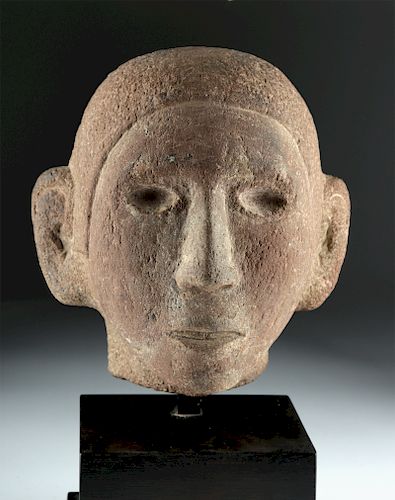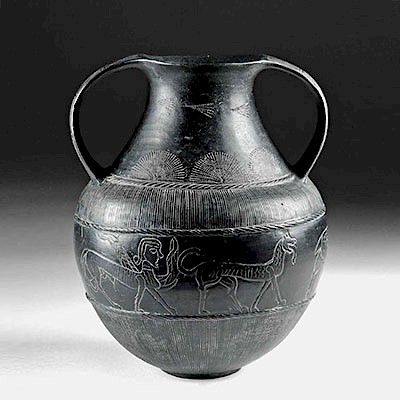Fine Aztec Stone Head of Young Man, ex-Sotheby's
Lot 189
About Seller
Artemis Gallery
686 S Taylor Ave, Ste 106
Louisville, CO 80027
United States
Selling antiquities, ancient and ethnographic art online since 1993, Artemis Gallery specializes in Classical Antiquities (Egyptian, Greek, Roman, Near Eastern), Asian, Pre-Columbian, African / Tribal / Oceanographic art. Our extensive inventory includes pottery, stone, metal, wood, glass and textil...Read more
Estimate:
$10,000 - $15,000
Absentee vs Live bid
Two ways to bid:
- Leave a max absentee bid and the platform will bid on your behalf up to your maximum bid during the live auction.
- Bid live during the auction and your bids will be submitted real-time to the auctioneer.
Bid Increments
| Price | Bid Increment |
|---|---|
| $0 | $25 |
| $300 | $50 |
| $1,000 | $100 |
| $2,000 | $250 |
| $5,000 | $500 |
| $10,000 | $1,000 |
| $20,000 | $2,500 |
| $50,000 | $5,000 |
| $100,000 | $10,000 |
| $200,000 | $20,000 |
About Auction
By Artemis Gallery
Mar 21, 2019
Set Reminder
2019-03-21 10:00:00
2019-03-21 10:00:00
America/New_York
Bidsquare
Bidsquare : Fine Ancient | Asian | Ethnographic Art
https://www.bidsquare.com/auctions/artemis-gallery/fine-ancient-asian-ethnographic-art-3967
Featuring classical antiquities, ancient and ethnographic art from cultures encompassing the globe, plus fine art. Egyptian, Greek, Roman, Etruscan, Near Eastern, Asian, Pre-Columbian, Native American, African / Tribal, Oceanic, Spanish Colonial, Russian, Fine Art, so much more! Artemis Gallery info@artemisgallery.com
Featuring classical antiquities, ancient and ethnographic art from cultures encompassing the globe, plus fine art. Egyptian, Greek, Roman, Etruscan, Near Eastern, Asian, Pre-Columbian, Native American, African / Tribal, Oceanic, Spanish Colonial, Russian, Fine Art, so much more! Artemis Gallery info@artemisgallery.com
- Lot Description
Pre-Columbian, Central Mexico, Aztec, ca. 1470 to 1521 CE. Finely carved from a red volcanic stone, the head of a young man with a naturalistic nose, slightly parted lips, almond-shaped eyes that would have been set with inlays - perhaps shell, obsidian, or another stone - nicely contoured facial planes, large ears, and a low cut coiffure. This plain hairstyle suggests that the head would have been furnished with different headdresses to represent various deities during festivals throughout the year. Recent scholarship also suggests that sculptures like this were intended to represent various states of intoxication via the consumption of pulque - a special Aztec beverage derived from the maguey or agave plant. Size: 8" H (20.3 cm); 12.25" H (31.1 cm) on included custom stand.
Pulque was one of several alcoholic drinks made from the fermented sap of the Maguey plant. (Tequila is another that may be more familiar to you, though it is distilled to make it stronger.) Pulque consumption was widespread throughout Pre-Columbian Mexico, and there were various gods and goddesses associated with it. Most notably, the Aztec god Tepoztecal was the god of alcoholic merriment. Pulque was served at religious ceremonies as a ritual intoxicant for priests and as a medicinal drink. It was also served in elaborate ceremonies to celebrate brave heroes of battle, and was so sacred as to be an acceptable substitute for blood in certain ancient rituals.
According to Deborah Toner, Lecturer at the University of Leicester, "Pulque’s special status as a material substance connecting together human, natural and divine worlds was also due to its intoxicating properties. Intoxication was understood as a state of instability and unpredictability that was also valuable as means of transferring between human, divine and natural states of being. Pulque – together with chocolate, tobacco, blood and hallucinogenic substances – fulfilled this special function, which was at the heart of much of the Aztecs’ religious and ritual life." (https://staffblogs.le.ac.uk/consumingauthenticities/2015/07/03/the-story-of-pulque-part-3-ritual-and-power-in-aztec-mexico/)
Deborah Toner also points to Aztec stone carvings of "drunkards" - very similar to this example - that display various emotional states following the consumption of pulque. See similar examples in the Nacional de Antropologia e Historia, Mexico City featured in Toner's article. (https://staffblogs.le.ac.uk/consumingauthenticities/2015/07/03/the-story-of-pulque-part-3-ritual-and-power-in-aztec-mexico/)
Provenance: ex-private Hawaii, USA collection; ex-collection of Dr. Allen A. Heflin, Kansas City, Missouri, USA; ex-Sothebys, New York (November 24, 1997, lot 346); ex-Stuart & Scott Gentling collection, Fort Worth, Texas, USA; ex-Bonhams, New York (November 12, 2014, lot 80)
All items legal to buy/sell under U.S. Statute covering cultural patrimony Code 2600, CHAPTER 14, and are guaranteed to be as described or your money back.
A Certificate of Authenticity will accompany all winning bids.
We ship worldwide and handle all shipping in-house for your convenience.
#138121Probably came from a larger free standing sculpture. Eyes would have had shell, stone, or obsidian inlays. Normal surface wear with some scuffs and abrasions. Losses to back of neckline as shown. "Morelos" handwritten in black on white on back of neck. Nice root marks and mineral deposits grace the surface.Condition
- Shipping Info
-
All shipping is handled in-house for your convenience. Your invoice from Artemis Gallery will include shipping calculation instructions. If in doubt, please inquire BEFORE bidding for estimated shipping costs for individual items.
-
- Buyer's Premium



 EUR
EUR CAD
CAD AUD
AUD GBP
GBP MXN
MXN HKD
HKD CNY
CNY MYR
MYR SEK
SEK SGD
SGD CHF
CHF THB
THB














